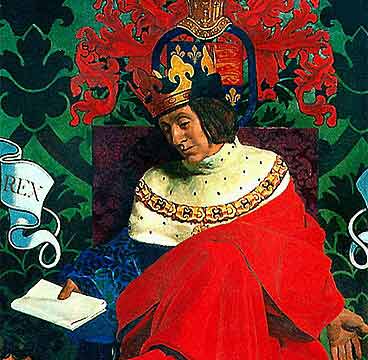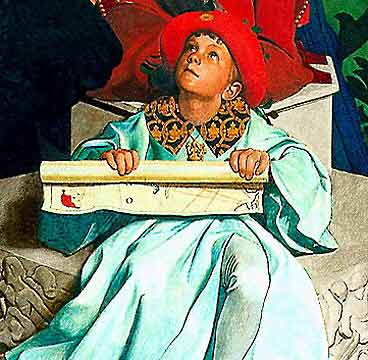John Cabot and his sons receiving a charter from Henry VII to search for new lands
© 2007
Armchair Travel Co. Ltd. - This page may be used for non-commercial purposes
ONLY!
![]()

[ Play
Narrated and Animated Movie ! ] On the throne sits King Henry VII. He leans forward, proffering a document to a man who kneels with his back to us. The kneeling man is John Cabot, an Venetian sailor born in Genoa, but resident in Bristol. In 1492 Christopher Columbus had discovered the West Indies: in 1496 Cabot obtained from Henry VII the first Royal Patent, authorising an adventure to discover new lands, and to take possession of them in the name of the king.
The picture shows Cabot's two sons: the smaller sitting at the king's feet, and the elder standing on the right-hand side of the picture, holding a scarlet banner. In 1497, Cabot discovered the island of Newfoundland and landed in Labrador, making him the first European of his period to land on the American continent. This early Tudor adventure became the basis of English territorial claims on the north American continent.
The original plan for the East Corridor, as set out by the Fine Arts Commissioners in 1847, was quite different from what we have today. It was to have contained such subjects as A Druidical Sacrifice and The Phoenicians in Cornwall on the one hand, with The Emancipation of Negro Slaves on the other. This ill-assorted scheme was abandoned early on, but it was not until 1907 that the new Liberal Government set up a committee for completing the decoration of the Palace of Westminster.
The new scheme for the East Corridor was to be historical events of the Tudor period. It is one of the most successful schemes in the Palace, whose unity is achieved by a colour scheme which is predominantly red, gold and black, and by the stipulation that the height of main characters in the pictures should not exceed 5'6" in height.
[ Virtual
Tour ] [ Main Topics
Index ]





Additional Information on
John Cabot and his sons receiving a charter from Henry VII to search for new lands
Explore-Parliament.net: Advanced Category Search
Keyword Categories:
_Object_Painting
_Object_Artwork
_Setting_England
_Event_Historical
_King
_Royal_Family
_Man
_Person
_Artist_Eden
_Henry_VII_